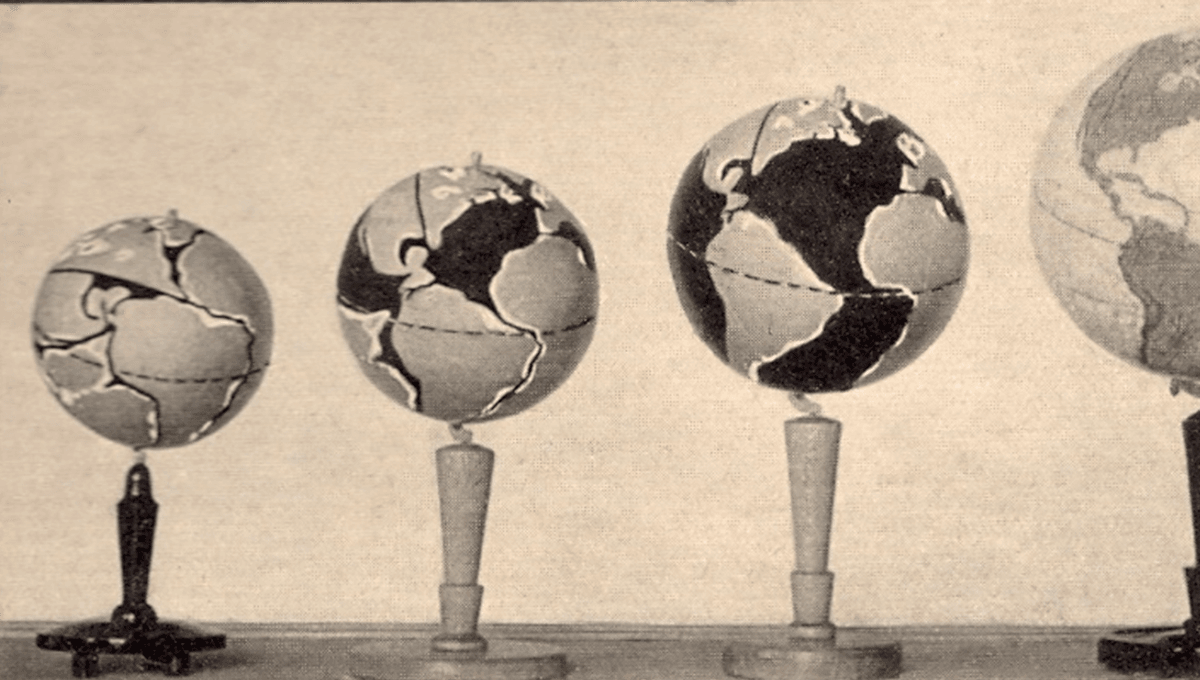Expanding Earth: The Strange (Pre-Tectonics) Hypothesis That The Earth Is Expanding Like A Balloon

Expanding Earth: The Strange (Pre-Tectonics) Hypothesis That The Earth Is Expanding Like A Balloon
The idea of plate tectonics – which describes how Earth's crust is arranged into slowly moving plates, with volcanic activity and earthquakes taking place along the boundaries – is so normal to us now that it might be surprising to learn it was only really accepted by geologists during the 1960s.
Before that, and the concept of continental drift, there were a number of other hypotheses for why we see the various landmasses and geological events that we do. Before continental drift, geologists were generally of the belief that the Earth's continents and oceans were permanent features on the Earth's surface, fixed in place and unmoving. In some ideas, the Earth was actually contracting due to heat loss, and this contraction over short geological timescales is what left the planet with mountains, sort of like how the shrinking Moon is left with scarps. And then there's the "expanding Earth" hypothesis. This idea, boiled down, is that the Earth is actually expanding (through various mechanisms, where they are proposed), and that is what moved the continents apart. At the time, the idea that the Earth was fixed but shrinking had some major drawbacks to it, being particularly unable to explain evidence of connections between the continents. "The expanding-Earth theory had the merit of explaining with a fixist model the evidence of ancient continental connections," a paper on the topic explains, "suggesting that continents fragmented and dispersed not because of lateral displacement but because of radial expansion while the planet was inflating." As continental drift proponents noted, the coastlines of South America and Africa fit together pretty neatly like a jigsaw puzzle if you take the time and effort to mush them back together again. While plate tectonics provides us with the answer that they were once together before the breakup of supercontinent Pangea, expanding Earth proponents had another idea. "The main argument for Earth expansion is the questionable claim that continental profiles have a perfect reciprocal fit on a smaller Earth, while mobilist reconstructions leave open gaps," the paper explains, adding that they worked on models of the planet at different sizes to see how the continents fit together on a smaller and smaller Earth. "The experimenters apparently failed to note that the process worked like a reversal of the contraction theory. Therefore, if the modern lithosphere had to adjust to a smaller Earth this would not just decrease intercontinental distances but also increase the deformation of the continents." While plate tectonics fits the geological data much better than an expanding Earth, what the expanding Earth idea really lacks is a mechanism for how the Earth inflates at all. In fact, some estimates suggest that the Earth is getting around 50,000 tonnes lighter every year as it gains a little dust and rock and loses massive amounts of gas to space. Looking into how much energy and mass the Earth would have to accumulate in order for the expanding Earth theory to be correct, it's not a small problem. "The gravitational potential energy of the actual Earth (at present) has been estimated as U=-2.485 × 1032 J. Since the actual Earth's body is relatively close to hydrostatic equilibrium, Poincaré's virial theorem gives an estimate of the internal energy of the Earth (at present) of about - 1.24 x 1032 J," one paper, looking at the amount of energy needed for expansion, explains. "The internal energy of the Earth required for expansion is about ~ 7 x 1031 J. No realistic origin of such energy could be found in the Earth-Moon-Sun system dynamics in the last ~ 450 x 106 y." For most, the idea has roundly been put to bed by plate tectonics and all the evidence behind it. But the idea has seen a resurgence as a strange, pseudo-scientific belief. There are still proponents of the idea, though they are much further on the fringes than they were in pre-plate tectonics days. One proponent, for example, suggests that the Earth was actually ejected from a gas giant during its early days, stripped of the outer gas by a strong solar wind. According to this idea, without that pressure, the Earth has been expanding ever since. But in this idea, Earth's density must decrease as it expands, or mass must somehow (???) be created within the Earth in order for Earth's density to not be changing over time. With plate tectonics providing a much better explanation, and being better supported by the evidence, don't expect the debunked expanding Earth hypothesis to grow into anything bigger.


